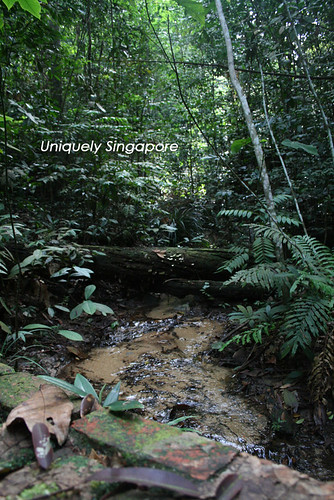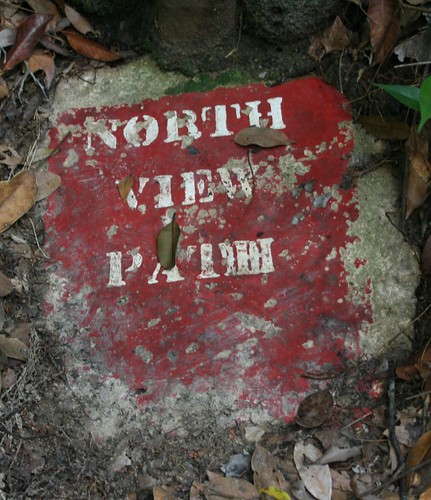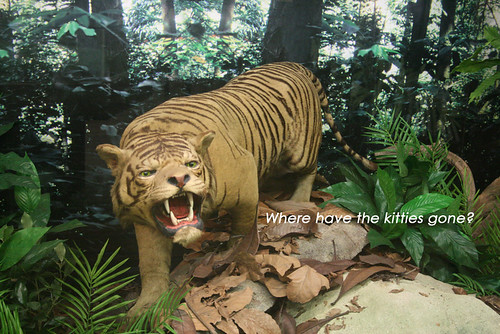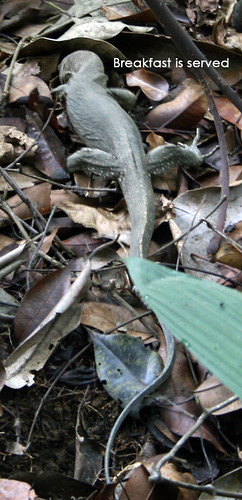
On this breezy Tuesday morning, the parents dropped monkey off at the Bukit Timah Nature Reserve visitor center in anticipation for an outdoors classroom session on Catchment Processes and Management. Yet, as early as 8am, it was already bustling with activities, not so much by the dozing long-tailed macaques but by the tailless primates known as Homo sapiens, already stretching their limbs for a early morning workout.
After a preliminary introduction, the class set off up the steep tarmac trek up the 163m hill, otherwise passing off as the tallest point in Singapore. Most of the time we were too busy looking at our feet as instructed as we were supposed to be examining signs of surface flow, erosion and sedimentation. The other half of the time, our out of shape conditions see us too busy catching our breaths rather than enjoying the bird calls and majestic dipterocarps around us.
The trail shortly led us to our destination - the once natural waterfall in our nature reserve. Sadly, it has since become of a rather piped consistency. Apparently, this was to prevent erosion and undercutting at the base of the waterfall. Still, now I actually understand why the trail is named Jungle Falls, sort of a tribute to the majesty of the previously largest natural waterfall in Singapore. Nonetheless, we did a bit of measurements and recorded a surprising (to the urbanites) velocity of 4 litres per seconds. Monkey made a close prediction of 3litres per second while some predicted a stingy 0.2litres per second. The piped conditions made it easy for us to actually measure the velocity without the usual cross section and width measurements or even using the currentmeter.
After a brief introduction to the various simple measuring equipments available to us (30m measuring tape, 3m measuring tape, penetrometer, clinometer, and soil type manual), we were then quickly dispatched to our assigned field site - the North View Path. Our group of 6 consisting of several animal friends like Hai~ren and Amazing Claudia is assigned to the trail from the junction with Seraya Loop to the North View Hut. I chanced across this old trail marker on the ground and could not help wondering how long this trail and marker has stand attest to time the presence of our first and of course, oldest nature reserve.
In the 1850s, the biggest threat in Bukit Timah was perhaps the Indo-Malayan Tigers that were reported to consume one chinaman each day. Today, the biggest threat to Bukit Timah is most definitely the largest predator in Singapore, the ever-hungry, recreational area consuming human enthusiasts. Even as we were there to think of how to study the impact by recreation, it occurred to me that there were no better people to observe then our own behaviors in the trails. How are we aiding to erosion as we sidestep the muddy tracks and unconsciously widening the trails? How are we undercutting the path further by digging in for a steadier foothold? Or even as we walk or poke the ground with walking sticks or even sands being kicked up as we climb the steps.
But even as we explore our trail, amazing claudia commented almost disappointedly that why was it that we haven't encountered any snakes! The professor in an earlier brief was joking that if we were lucky we might meet a few. Yet seeing how we were noisy and loud, discussing our subject at hand, we hardly took the time to listen out for rustling in the leaf litter. Hai~ren also speculated that our trampling about on the trail has probably scared our reptilian friends away. At many points during the morning, monkey felt absolutely guilty for failing the first rule to correct behavior in a nature area - silence. I must have been a howler monkey in my previous life. The quasi nature guide in me kick start to life and decided to just stop talking and start listening. Within seconds, we chanced upon two squirrels - possibly slender, or plantain but there are only that many species in Singapore. (edit: as suggested, it may have been a tree shrew afterall!)
 Although we didn't see any snakes, but we did meet a reptile of another sort - a clouded monitor lizard (Varanus bengalensis nebulosus ). This juvenile was busy digging for breakfast when monkey heard a soft rustle in the leafs and spotted a tail and 4 feet sticking out of the ground. At some point, monkey even got some soil in the face courtesy of the little fella in its enthusiasm to find some grub for breakfast. It was very interesting observing him for all of 5 minutes before we realized we were taking too long with these nature-appreciation stops on the way to the summit. But all in all, stopping to appreciate the reserve for what it is - a home, a habitat, an ecosystem to millions of living things - was definitely more rewarding than those overheard saying "I'll scream if I see anything that moves!"
Although we didn't see any snakes, but we did meet a reptile of another sort - a clouded monitor lizard (Varanus bengalensis nebulosus ). This juvenile was busy digging for breakfast when monkey heard a soft rustle in the leafs and spotted a tail and 4 feet sticking out of the ground. At some point, monkey even got some soil in the face courtesy of the little fella in its enthusiasm to find some grub for breakfast. It was very interesting observing him for all of 5 minutes before we realized we were taking too long with these nature-appreciation stops on the way to the summit. But all in all, stopping to appreciate the reserve for what it is - a home, a habitat, an ecosystem to millions of living things - was definitely more rewarding than those overheard saying "I'll scream if I see anything that moves!"
It does make one wonder at the kind of lessons we need to include in our curriculum that will actually teach our future decision makers, scientists and even citizen constituency alike the importance of looking at things holistically, beyond your assigned task. Why go about your task, whether you are biologists studying a particular plant or microbe or geographers studying a river. You need to appreciate the other factors beyond your realm. If you have no love for the environment at large, how effective a practitioner would you become? If you are unable to make holistic, all encompassing decisions in the future, how could we trust our homes to you? We want to know that you would be making the best decision for all of us, and not just thinking about your own bread and butter.
Where is the love? Indeed, where is the love!
Related Reads:
Tuesday, January 23, 2007
Outdoors Classroom @ BTNR
Posted by
Monkey
at
Tuesday, January 23, 2007
![]()
Labels: Education, Environment, Geography, Nature

 I can be contacted at
I can be contacted at 







8 comments:
*poke* Yay you finally blogged! Oh and nice pics of this morning's trip.
Eh I think the long-extinct tigers in Singapore were the Malayan subspecies, not Sumatran.
I suddenly thought of something. Maybe the squirrels we saw weren't squirrels but actually common tree shrew. Completely slipped my mind at that point in time. Aargh should have gotten a better look at the snout.
How to develop a holistic view when young people do not read beyond their textbooks or go beyond their usual Orchard areas? We need to develop our love for the environment by exploring more, eg. going to BTNR or reading widely... To quote from E.O.Wilson's The Creation, "From the freedom to explore comes the joy of learning. From knowledge acquired by personal initiative arises the desire for more knowledge."
you see that's the problem!
I do not know how to get these people to look beyond their cup of tea.
Here they are in BTNR but they are not appreciating BTNR for what it is beyond the task assigned by the teacher and that perhaps they would not even be there if not necessitated by the module!
No answer to that... maybe have a BTNR appreciation module? The problem is partly a result of our education system and national emphasis on economic growth. Someone said before that if you want everyone to be environmentally conscious, either you keep on reminding them till they get it or you wait for those that don't get it to die naturally.
Garrett Hardin will probably disagree with the last statement about them dying naturally. No, in fact they will keep increasing in numbers lol not if we do something about it.
Anyways, I don't think the issue is with emphasis on economic development but something that many people has pointed out repeatedly this last decade. Our children are increasingly urbanites who are disconnected with the natural environment. But this is a good question to ponder on - how to get people to look at things holistically and not so centered on their own disciplines. The university system's fragmented discipline specialization system has long been criticized but it's difficult to overcome certain egos.
you sure its V. bengalensis? I haven't heard of that species in Sing? I could be mistaken tho.
you can refer to this ecology asia website about the clouded monitor lizard
http://ecologyasia.com/verts/lizards/clouded_monitor.htm
Post a Comment